Welcome back, reader! That is, welcome back to my blog if you’ve visited it in the past and have returned to read another post. If this is your first time here, I extend a regular but just as hearty “Welcome!” to you.
On Saturday, 6 May, I left Europe and returned to the United States, officially ending my semester abroad. Having left on 7 January, I spent just about four months in Europe. My time in Toledo through St. Norbert College was quite short compared to other study-abroad programs: 3.5 months, when other SNC students abroad had/have classes from the beginning of January to mid-May in France, from mid-February to the end of June in New Zealand, and from the beginning of April to the end of August in Japan. Of course, differences in duration do not make any one program better than another, but it was interesting for me to feel ready to come home and joyful upon doing so and then see the activities of other Fund students and SNC students who continued to travel past my departure or are still doing so now.
I spent my last week in Europe traveling with my friend Alyssa, another SNC student who spent her semester abroad in London. We started our travels with a whirlwind one-day exploration of Venice on Sunday, 30 April. On Monday, 1 May, we arrived in the city of Brno, the Czech Republic, on our way to that country’s capital of Prague, where we would stay until 3 May.
Our Regiojet bus arrived in Brno around 6:30 a.m. We switched to another Regiojet bus that left at 7:30 a.m. and arrived in Prague around 10:20 a.m. I really enjoyed this last leg of the journey: the Czech countryside reminded me a lot of Wisconsin in the late spring and summer with its verdant green fields, rolling hills, and small towns.
The language did not prove quite as familiar, however! Czech, a Slavic language, baffled my ears and brain when I heard it, since it is a Slavic tongue rather than Germanic (like English) or Romantic (like Spanish). I think that it discombobulated me more than a more foreign language, such as Arabic or Chinese, would have because I had an ingrained expectation that it would instantly sound familiar. Learning that the Czech word for “yes” is ano, however, proved that assumption a bit unfounded. At the same time, as one of my friends from the Czech Republic pointed out, Czech and most other Slavic languages are easier to learn than English. I’ve definitely come to have more gratitude for knowing English as my native tongue over the course of my time abroad; its many, oft-broken and oft-contradicted rules, both written and intuited, make it pretty difficult for non-native speakers to learn.
Once we arrived at Florenc, the main bus station in Prague, Alyssa and I made our way by metro and electric tram to Pohořelec (literally, “the scene of fire,” due to the many fires that have broken out in its square over the centuries), a section of Hradčany, the Castle District that contains, unsurprisingly, Prague Castle. Right by Pohořelec is the district of Strahov, in which sits Strahov Abbey, a Premonstratensian monastery where Alyssa and I would be lodging during our stay in the city. The canons here, thanks to the help of Father Ciferni, the director of the Center for Norbertine Studies, had graciously reserved a set of rooms for us and agreed to give us a tour of their home. Before I go on: Thank you, Fr. Ciferini and the canons of Strahov! Your generosity is deeply appreciated and made our stay in Prague truly unique and wonderful.
After putting our bags in our room and unpacking a bit, Alyssa and I had lunch with the canons in their refectory. It was nice to meet them as a group and to try some typical Czech cuisine. I never found out the exact names for what we ate, but it was all delicious!
After lunch, I went on a walk alone through the grounds of Strahov. The community was established after the bishop of Olomouc, Jindřich Zdík, made a pilgrimage to the Holy Land in 1138. He decided to found a community of regular canons in Prague on his return, but the first community struggled to survive. Zdík thus invited Premonstratensian (Norbertine) canons from Steinfeld, an abbey in the Rhine Valley in Germany. The Premonstratensian Order had been founded just two decades before by Saint Norbert in northern France, but the order had been enjoying great popularity and growth in Europe. The Norbertines from Steinfeld established themselves in Prague in 1143 and, through ups and downs over the centuries, have survived to the present day.
Between 1950 and 1989, the abbey was controlled by the Communist regime of Czechoslovakia. During this period, the other Norbertine abbeys in the region were destroyed, along with most religious houses behind the so-called Iron Curtain. Strahov Abbey was kept relatively intact due to its smaller size. Looking at it and its size today, I cannot imagine how large the other abbeys in Bohemia were!
Since 1994, after an extensive restoration, the canons of Strahov returned to their historic home, and the abbey and grounds have since been a major tourist site, as well. There are restaurants and tourist shops on the abbey grounds today, but the biggest draws are its stunning architecture and especially its two libraries, the Philosophical and Theological Halls. It was odd to be in Strahov and see so many people who obviously knew about it and wanted to see it. In most other areas of Europe and especially in America, the Premonstratensians/Norbertines are a relatively unknown order, even though they had a significant presence in Western and Central Europe until the 1800s.
Alyssa and I would have an official tour of the abbey the next day, but for now I simply looked in the church (the Basilica of Our Lady of the Assumption, with a Baroque design from the 1740s) and then walked in the park the adjoins the monastery.
It was an absolutely beautiful day: the trees were in flower, there was a beautiful view of Prague, and many people were walking in the park. It was actually Labor Day in the Czech Republic (and much of Europe), so a lot of people had the day off work and there were celebrations throughout the city.
After I returned from my walk, Alyssa and I went on a walk downhill east from Strahov, toward the Vltava River and Prague’s New Town (“new” as in from the 14th century compared to older sections of the historic city center). On the way, we saw the Church of Saint Nicholas, many beautiful Baroque buildings, and tons of souvenir and food shops. Once we reached the Vltava River, we crossed the Legion Bridge, passing over Střelecký Island on the way, and reached the National Theatre in New Town. After watching a Communist Party protest-parade pass by, we walked to the Charles Bridge in the Old Town district.
The Charles Bridge was constructed in the fourteenth and early fifteenth centuries by the order of King Charles IV (1346-1378), who presided over Bohemia’s Golden Age and was also crowned emperor of the Holy Roman Empire in 1355. The Charles Bridge is the most famous of Prague’s many bridges, with over 30 statues of various saints (including one of Saint Norbert!), a Gothic bridge tower on its Old Town end, and numerous tourists each day.
Alyssa and I crossed the bridge and made our way back to Strahov, stopping for trdelník on the way. What is trdelník, you ask? Good question! It is a “chimney cake” made on a spit and covered in sugar and walnuts and a traditional dessert in Central Europe. However, its popularity has surged in the last decade among tourists in Prague, opening up a whole new world of toppings possibilities, including cinnamon, berries, and chocolate. You can even get a trdelník filled with ice cream! I ended up getting the basic version of the cake and a raspberry tea with it: both were scrumptious. After enjoying our cakes, Alyssa and I bought some groceries for the next two days and then returned to Strahov, from which we soon departed for the park I had visited earlier in the day.
In the park, Alyssa and I climbed the Petřín Lookout Tower, a structure built in 1891 as an observation and transmission tower that strongly resembles the Eiffel Tower in Paris (which I would visit later the same week). It is significantly shorter than the Eiffel Tower but also, technically, taller due to its location on a tall hill overlooking Prague. There were certainly magnificent views of the city in the twilight once we climbed up the tower. I found myself charmed again and again by the Baroque architecture of Prague; I felt very at home there, somehow.
After the tower, Alyssa returned to the abbey, while I went to the other touristy attraction in the park, the Mirror Maze (Zrcadlové bludiště Petřín, in Czech). Like the Petřín Lookout Tower, it was built in 1891 for the General Land Centennial Exhibition, the World’s Fair for that year. It is basically a hall of mirrors, but it sure was a lot of fun to explore! It also includes a diorama of the battle between Czech and Swedish soldiers on the Charles Bridge in 1648 right in its middle, an interesting break between the two mirror sections. Once I was done in the Mirror Maze, I went back to Strahov, ready for a good night’s rest after spending the last night on a bus. Even a bus as nice as the ones run by Regiojet are not quite as good as a soft and clean bed!
On Tuesday morning, Alyssa and I had breakfast with the canons and then shortly after were taken on a tour of Strahov Abbey. Our first stop was the Philosophical Hall, a gorgeous library built in an early Classicist Style at the end of the eighteenth century. Despite having two stories, the space has no obvious staircases, but our guide pointed out a bookcase that had fake books on it as the door to a hidden staircase up to the top level. In addition, he showed us a chair built into a desk that one could simply roll out and then sit in and a rotating book arm. Basically, this was my dream library!
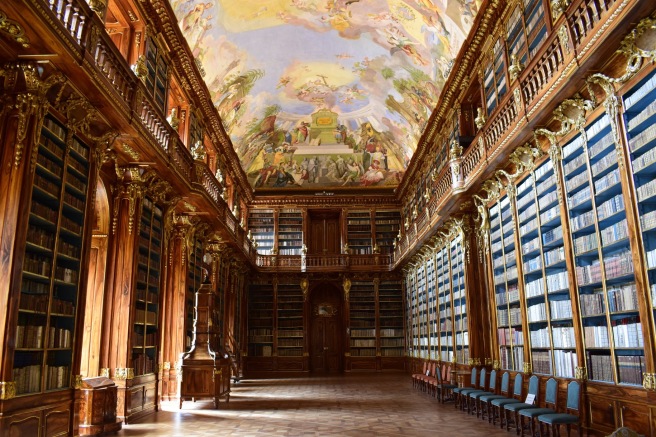
From the Philosophical Hall, we walked through the museum of the monastery to the Theological Hall, viewing old and valuable manuscripts and other objects the abbey had acquired over the centuries of its existence. The Theological Hall, built in the 1670s in the Baroque style, also blew me away with its beauty.
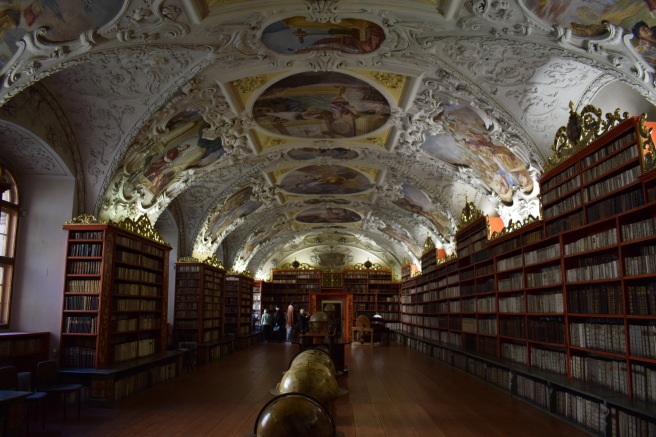
Our tour also took us to and through the church of the abbey, including the choir stalls where the canons sit for the Liturgy of the Hours and the chapel containing the relics of Saint Norbert. Norbert died in Magdeburg, Germany – where he had been serving as archbishop since 1126 – on 6 June 1134 (his feast day), and his remains were buried there for centuries. In the 1520s, however, the city converted to Protestantism, requiring the bones to be moved. It took about a century, but the remains of Norbert were finally brought to Strahov Abbey on 2 May 1627, an event known as the traslatio. Alyssa and I were seeing these remains (in a golden container in the chapel) on 2 May, as well, exactly 390 years after the traslatio occurred: it was a surreal moment!
After the church, we saw more of the abbey’s museum and eventually ended up on a patio overlooking the city of Prague. It was another fine day, and the city spread out beneath us in the morning sun. If I had admired Prague yesterday, today I loved it!
Our tour finished just after 10 a.m., so Alyssa and I decided to visit one of the main historical and tourist sites in the city, Prague Castle or Pražský hrad. Dating back in its oldest sections to the ninth century, it is the largest ancient castle in the world, with a total surface area of 7.28 hectares (or 18 acres for us Americans). The castle today serves as the official residence of the president of the Czech Republic, as well as, in a secret room, the crown jewels of the Bohemian royal family.
The castle is also a complex that contains St. Vitus Cathedral, St. George’s Basilica, two other small churches, and an impressive array of gardens. The gardens and the main square of the castle are free and open to the public, while the interior of the castle, St. Vitus Cathedral, and other sites require a paid ticket entrance.
Alyssa and I first visited St. Vitus Cathedral, a Gothic church that was actually dedicated to Saints Wenceslaus and Adalbert too in 1997 but still mainly goes by St. Vitus. Built in the fourteenth century but only completed in the twentieth, it is the largest church in the Czech Republic and a magnificent example of Gothic architecture.
From the cathedral, Alyssa and I walked to the castle. In our tour of it, we had the opportunity to see the window of the Defenestration of Prague in 1618. For a history major and lover like me, this was a dream come true! (Click the link if you don’t know about it.) Perhaps my favorite part of the whole episode is the word “defenestration” itself. I mean, how often do you get to use this word meaning “to throw out of a window”?
In our journey through Prague Castle, we also saw the throne room, St. George’s Basilica, the Golden Lane (a street of small houses in the complex that received its name from the goldsmiths that lived there in the 1600s), medieval torture instruments (always fun!), a dungeon, and replicas of the Bohemian Royal Jewels. We ended our day at Prague Castle by going through two museums about the history of the castle, the royal families that lived within it, and the region of Bohemia.
Once we exited Prague Castle, we caught a tram to Prague’s New Town and walked to its Old Town Square, the other major tourist site in the city. The big draw here is an astronomical clock built in 1410 that, amazingly enough, still functions, making it the oldest operating astronomical clock in the world. Charming and impressive buildings line the square and stand close to it, too, so there were understandably a lot of people milling about. Alyssa and I looked around a little and then headed back to Strahov in order to arrive in time for the 6 p.m. Mass.
I must admit I didn’t understand much of the Mass, it being all in Czech, but it was still wonderful to attend it, especially when the canons and the locals sang a song to Mary after the Mass (May being the month of Mary).
After Mass, Alyssa and I treated ourselves to a fancy dinner at one of the restaurants on the Strahov grounds. We ate typical Czech food, such as sausages, Czech dumplings (a mix of wheat and potato dumplings), marinated beef with cream and cranberries, and plum dumplings. We also tried Strahov beer: Strahov, like Grimbergen and many other Norbertine abbeys, has beer recipes from centuries ago that it has given to a company to make and sell in return for a portion of the profits. It was a relaxing and delicious way to spend our last night in the city.
Wednesday morning, I went for a walk and encountered the Černín Palace, today home of the Czech Republic’s foreign ministry and the site of the official dissolution of the Warsaw Pact in 1991. Just across from it, I saw the Loreto, a beautiful church. Further on, I came to the west end of the Prague Castle complex and, right outside of it, the Archbishop’s Palace. It was a glorious morning to see all these detailed and enchanting buildings, and I came back to Strahov ready for a great day – and breakfast!
After breakfast, I went inside and looked around St. Nicholas Church, dedicated to that famous bishop of the fourth century who provided the base image for Santa Claus. This large church is an impressive example of Baroque architecture, and it was amazing to stand inside it and simply stare. I’d seen advertisements outside this church and other locations throughout the city for concerts of classical music throughout the month of May. I can’t imagine how amazing it must be to hear beautiful music performed in equally beautiful spaces!
From St. Nicholas Church, I went to the nearby Church of Our Lady Victorious. It houses the Infant of Prague, a statue of the infant Jesus that attracts pilgrims from all over the world, especially Spain, Portugal, and nations that were colonized by them. The church is run by Carmelites, the order reformed by Saint Teresa of Ávila; tradition holds that the image belonged to Teresa herself. Whatever its origins, the Infant of Prague is a popular sight for tourists and especially religious visitors to the city. I enjoyed my visit there, though I must admit some of the care given to the statue, especially in the elaborate costumes made for it over the centuries, seems a bit excessive to me.
After visiting the Infant of Prague, I went to the Czech National Museum’s music museum, full of instruments and musical accoutrement from the Renaissance to the modern day. From there, I walked to Charles Bridge, and this time I found the statue of Saint Norbert with Saints Sigismund and Wenceslaus and got a picture with them from a friendly tourist. I felt like I had to, given that one doesn’t see statues of Saint Norbert many places!
I walked back to Strahov from Charles Bridge. There, Alyssa and I ate lunch, packed out things, checked out of our room, and headed to Florenc for our bus that would leave at 5 p.m. for Paris, France. We arrived in plenty of time, allowing me to use my last korunas (the Czech currency) to buy us kolache and koblihy, traditional Czech sweet pastries.
The bus we took this time was from Flixbus, one of the most popular European bus companies. Though it didn’t have seat-back screens or free drinks, it was just as comfortable as the Regiobus to Prague. It even had two levels, so Alyssa and I had a beautiful vantage to watch the Bohemian, and later German, countryside roll past as the evening wore on.
I really enjoyed my time in Prague, and I hope to return there some day. My experience was made that much better both by having Alyssa with me and by staying at Strahov Abbey thanks to the generosity of its canons. To Alyssa and to Strahov, thanks!
Our Flixbus arrived in Paris around 6:30 a.m. Thursday morning. Alyssa and I made our way from the station to our hostel in the north of the city, close to the famous Mouline Rogue theatre and Sacré-Cœur Basilica, the Basilica of the Sacred Heart of Jesus. Much to our surprise and frustration, the Paris subway system has very few escalators: we got quite the workout lugging our suitcases up and down multiple sets of stairs!
After leaving our luggage at the hostel and freshening up a bit, we headed out and climbed up to Sacré-Cœur. This imposing church built in the Romano-Byzantine style in the 1870s sits atop Montmartre, the highest point in Paris. It thus commands an impressive view of the city. Unfortunately, it was a chill and foggy morning when we visited the basilica, so the vista was not quite as clear or incredible as it could have been. The interior, however, was of course unaffected and dazzled me with its mosaics. Our visit, so early in the morning (around 8:30 a.m.), coincided with the last sections of Lauds, or Morning Prayer, from the Benedictine sisters who live near the church. Their ethereal voices floated through the church and made my experience there truly touching and incredible.
Close to Sacré-Cœur is the much-older church of Saint Peter of Montmartre; Alyssa and I visited it after the basilica. The earliest church known to exist on the site was established in the ninth century; the current structure was rebuilt in the Romanesque style in the nineteenth century after being destroyed in the French Revolution. It had a more intimate atmosphere than the basilica due to its small size and was another site I was grateful to have visited during my time abroad.
From Montmartre, we went back to our hostel for a few minutes and then headed via the metro to the Arc de Triomphe. I knew this was a large structure, but I was completely agape when I saw just how large this arch was! I can see why it is such a popular destination for visitors to the city. Thankfully, we did not have to negotiate the roundabout to get to the arch; underground passageways link the surrounding boulevards to it.
Alyssa and I took one of these boulevards to another famous structure in Paris: the Palais Garnier, the main seat of the Paris Opera until the construction of a new opera house in 1989. The building takes its name from Charles Garnier, who oversaw construction of the opera house from 1861 to its completion in 1875. This building is bursting with decoration, reader: it’s been called the one true masterpiece of France’s Second Empire and also been criticized for gaudiness. I found the Palais Garnier magnificent, especially because it was the site of Gaston Leroux’s famous novel (later adapted to a musical and many films) The Phantom of the Opera. I got to see and climb the Grand Staircase, step into the auditorium, and walk through the Grand Foyer; it was superb!
After exiting the Palais Garnier, Alyssa and I took the metro and walked to the Île de la Cité, one of two natural islands in the Seine River and at the center of Paris. Here is where one can find the Cathedral of Notre-Dame de Paris, one of the most well-known churches in the world. I was humbled, ecstatic, and a bit incredulous to be visiting this sacred site, and, even with all the people jostling each other inside the structure, I appreciated and still cherish the time I had there.
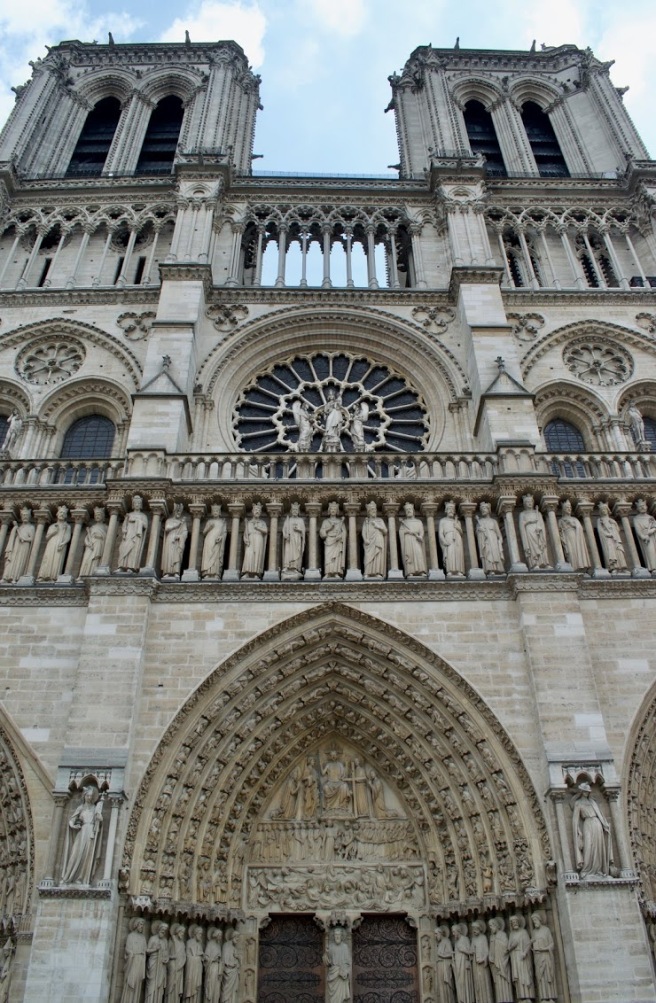
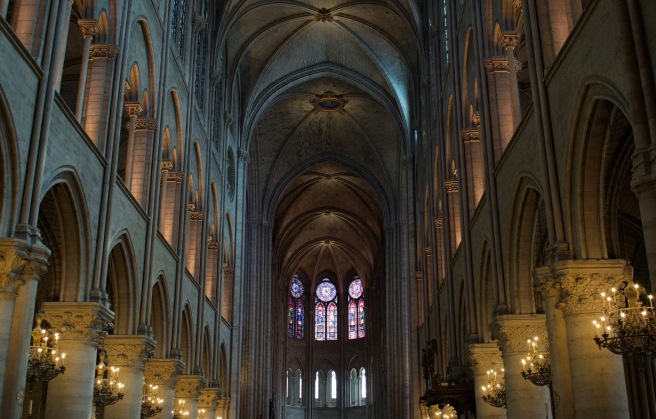
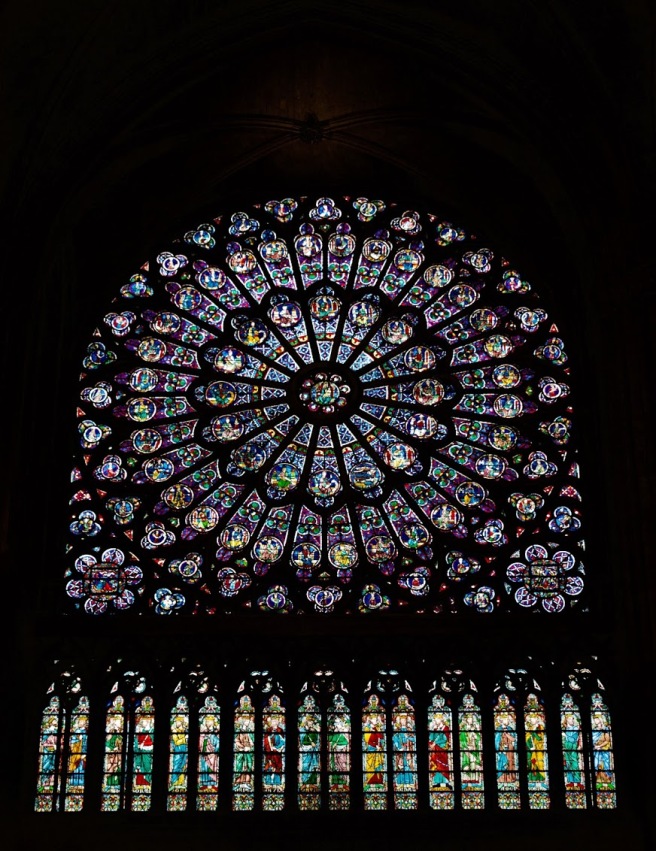
From Notre-Dame we walked across and then north along the Seine, where we saw many book, art, and – of course – souvenir vendors. We reached the Louvre museum complex and walked around it but decided to visit the Musee D’Orsay instead. This museum houses works from artists of the nineteenth and twentieth centuries, including Vincent Van Gogh. Thankfully, the museum has extended hours on Thursdays, so we were able to spend a lot of time viewing the art there. Not only were these pieces beautiful; so, in my opinion, was the interior of the Orsay!
After a day full of walking and touring, Alyssa and I returned to our hostel, making a stop at a supermarket a block away for food. The next day, we would meet with my friend Amy from the Fund in Toledo and tour the Palace of Versailles and the Eiffel Tower.
It was great to see a familiar face from the Fund so soon after leaving it! Amy met us at our hostel, from which we traveled to a station for the train to Versailles. The Château de Versailles was built by King Louis XIV of France, or the Sun King, in the late 1600s to serve as the seat of the French government and showcase his wealth and power as the absolute monarch of France. As if the 721,182 square-foot, 700-roomed palace weren’t enough, the royal compound also includes 800 hectares (1976.84 acres) of gardens and two smaller palaces, the Grand Trianon and the Petit Trianon, that were built by Louis XIV and Louis XV, respectively, to serve as retreats from the bustle of life at Versailles proper. Visiting all of these locations on Friday while knowing the poverty and hardship of the vast majority of the people in France during the late 1600s and 1700s made the anger and acuteness of the French Revolution more understandable to me.
We first went through the Gardens of Versailles, which today had Baroque music playing throughout their speaker system to entertain visitors. The landscaped gardens through which millions of tourists walk each year actually form only a small part of the Gardens; the rest is cultivated woodlands. I could make a whole separate blog post about the Gardens, but I won’t get into much detail here. Suffice it to say that they were impressive and, even just in the landscaped sections, immense. For history, photos, and routes of the Gardens, try the official site of Versailles.
Halfway through our tour of the gardens, we walked from them to the Estate of Trianon and toured the Grand and Petit Palaces. While certainly smaller than the Château, these were still palaces and thus pretty darn large for a Midwesterner like me. These estates have their own gardens, including an imitation English hamlet and farm that Marie Antoinette ordered built during her time as France’s queen.
From the Grand and Petit Trianons, we resumed our tour of the Versailles Gardens, eventually making our way back to the palace. We entered the monumental building complex and saw its royal chapel first. “Chapel” makes you think of a small room; this two-story space full of decoration and nearly as big as Old St. Joe’s Church in De Pere most certainly was not!
Much like the Doge’s Palace in Venice, I was flabbergasted by the sequence of opulence as we passed through giant room after giant room of ornate and expensive architecture, decoration, and furniture. There were also plenty of portraits of the kings of France, especially Louis XIV, a fact that did not surprise me that much given that this was the man who epitomized, even though he probably never actually said, “L’etat, C’est moi,” (“I am the nation.”) in reference to the country.
The best known room in the palace is the Hall of Mirrors (Galerie des Glaces in French), a corridor linking the Queen’s and King’s apartments bordered by windows on one side and mirrors on the other. Mirrors at this time were highly expensive (in fact, the Republic of Venice had a monopoly on the product), so you can imagine just how great a display of wealth and power this room displayed when it was finished in the late 1600s.
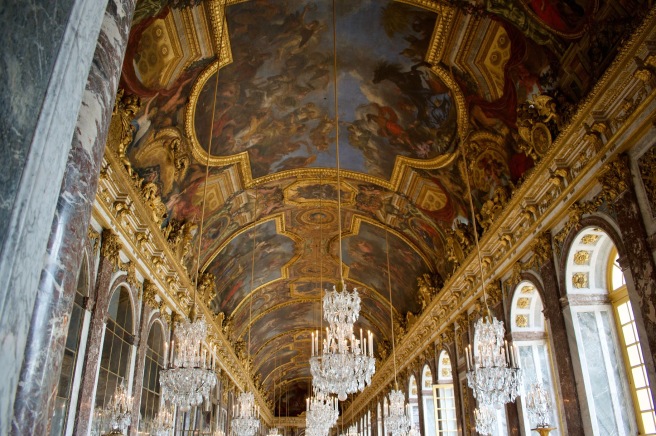
After the Hall of Mirrors, we toured the War and Peace Rooms and a statue gallery of famous philosophers, kings, and religious figures through the ages. With those sections explored, our time in Versailles came to an end, just as the complex was closing, in fact. I was and am so grateful to have explored this mind-bogglingly luxurious palace and its grounds with good friends.
We got off the train from Versailles at the station closest to the Eiffel Tower and proceeded to walk there. Even though it is today perhaps the best-known and most-reproduced symbol of Paris, the Eiffel Tower was only built between 1887 and 1889 for the World’s Fair in 1889 and was meant to stand for only 20 years. However, Gustave Eiffel’s massive work of wrought iron was maintained beyond that point, with its creator’s encouragement, and still stands to this day. According to its website, it is the most heavily visited monument one must pay to visit in the world, drawing around seven million visitors each year.
When we first arrived at the tower, we simply gazed at it in the setting sun. Then, we walked across the Seine in search of a restaurant for supper and eventually settled on a sandwich cart close to the bridge we had crossed. My three-cheese sandwich was delicious, easily on par with (perhaps even, dare I say, better?) than the best grilled cheese sandwiches I’ve had in Wisconsin.
After our supper, we returned to the Eiffel Tower, went through security, and waited in line for about an hour before going up to its second tier. The top tier was closed, apparently a common occurrence, but that wasn’t a problem for me: the second tier still gave a breathtaking view of the city, lit up now that it was night. The tower itself was just as striking as in the daytime, and we even caught one of its light shows before we descended to the ground. We only ascended the Eiffel Tower thanks to Amy’s desire to visit it, so thank you so much, Amy! I’m so glad we waited for such a spectacular sight.
It was now around 10 p.m., so we headed to the nearest metro station and back toward our hostels. Alyssa and I said hasta luego to Amy at our stop and walked to our hostel, where we packed for our departure then next day and then went to bed.
The next morning, we enjoyed the free breakfast offered at our hostel for the second time: a free baguette piece and croissant with jam and butter was a great way to start the day! We then checked out from the hostel, got on the metro, changed to a train to Charles de Gaulle Airport, and finally took a tram to our terminal. Thankfully, unlike the metro system itself, the airport had escalators everywhere!
It was weird to be back in Charles de Gaulle, now waiting to depart Europe four months after arriving and worriedly waiting for the SNC class to find me and go to Mondaye Abbey. I was happy to be going home, but I knew, as I know and feel now, that I would miss Europe and all the things I had seen and done there, not to mention the delicious cuisine I had tasted and, above all, the remarkable people I had me.
A funny thing happened as our flight was boarding. I looked ahead in the line, and there I saw Adam, the SNC student who had also gone to Mondaye Abbey with Father Ciferni’s class and who had traveled with me from there to Toledo to study at the Fund. It was an unexpected but pleasant surprise to see another classmate before heading home!
The flight to O’Hare went smoothly. I had another pleasant surprise in finding out that the two other people in my row were also Wisconsinites! We arrived safely (and, to my pleasant surprise, ahead of schedule) at O’Hare around 1 p.m. Central Standard Time, or 8 p.m. in Paris. After making my way through security and getting my baggage, I walked out the doors to find my parents and grandmother waiting for me. It was so nice to see them after four months of separation, and they seemed just as glad to see me. At the airport, I bid farewell to Alyssa, who had been such a patient and knowledgeable travel buddy over the past week. Alyssa, thank you so much for making my last week in Europe fantastic!
From the airport, my family drove me back to Plover. On the way, we stopped at two of my favorite places: Culver’s, that staple of Midwestern fast food, and Gille’s, a drive-in restaurant with delicious custard in Fond du Lac. My stomach was definitely unaccustomed to American food after four months abroad, but I ignored its protests for the moment and enjoyed my cheeseburger, fries, lemon ice, and – best of all – custard in bliss.
I managed to stay up most of the day after arriving in the United States. I even stayed up later than I probably should have unpacking, especially since I would have to get up early the next day for Mass. My neatnik nature compelled me to get as much as I could unpacked and organized, however; at least it got done quickly!
On Sunday, I attended Mass at my home church of Saint Bronislava, an odd but enjoyable experience after months of mainly Spanish and sometimes Czech, Italian, Dutch, French, and English Masses. Though the church is from the 1990s instead of the 1700s or earlier, it was nice to be back and worship there (and, even though it wasn’t necessary anymore, heating!).
I continued organizing my things on Sunday and uploading photos while my oldest sister visited. It was a relaxing day and one much appreciated after the frequent travel of the past week and, in general, the past four months.
And that, reader, was my last week in Europe. I’ll be writing a post reflecting on my experience abroad in the future, and that should pretty much wrap up my study-abroad posts. Thank you so much for reading my posts, whether every single one of them or only this one. I hope that you have had or will have the opportunity to go abroad or travel much within your own country and have experiences as and more wonderful than my own. As Saint Augustine never actually said, “The world is a book, and those who do not travel read only one page.” Ever the logophile, I’d like to read as more pages of this grand book in the future, but for now I am grateful for the ones I have been able to view.
Again, thank you, reader. Until the next post (and ever after), may God be with you.

